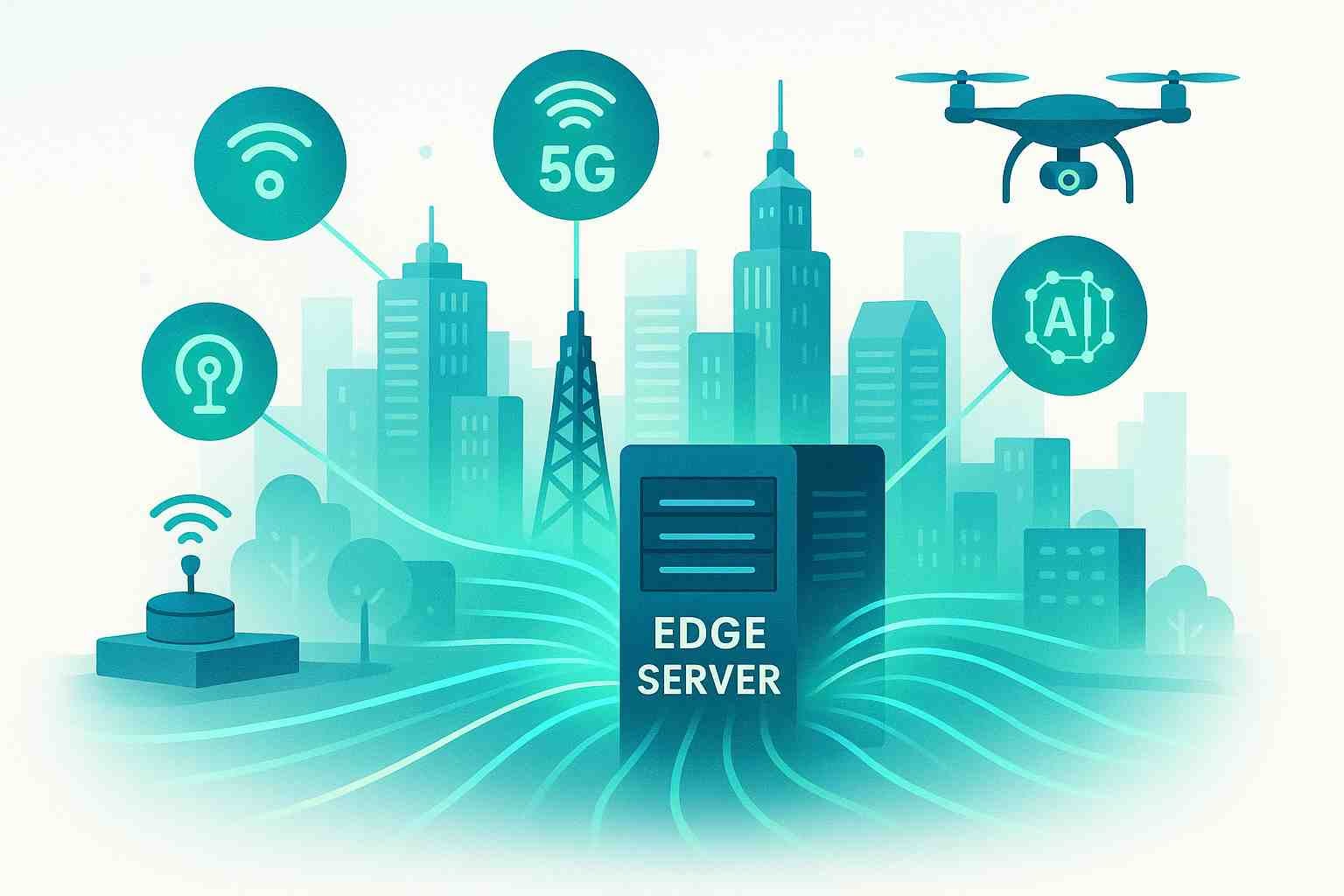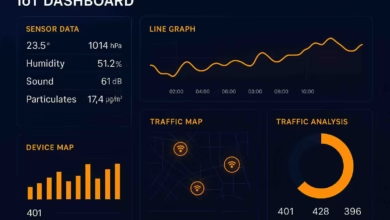Edge Computing in 2025: The Ultimate Guide to Transforming IoT, 5G, and AI Innovation

Edge Computing in 2025: The Ultimate Guide to Transforming IoT, 5G, and AI Innovation
Edge Computing: The Engine of Tomorrow’s Tech
In 2025, edge computing is redefining how we handle data, bringing processing power to the edge of networks—closer to devices like IoT sensors, 5G-enabled cars, and AI-powered cameras. This shift slashes latency, optimizes bandwidth, and fuels real-time innovation. With the edge computing market projected to hit $43.4 billion by 2027 (Statista, 2025), it’s a game-changer for industries from healthcare to smart cities. This BytesWall guide unpacks edge computing’s essentials, tools, use cases, and career paths to help you lead the charge. Explore more tech trends in our innovation insights.
Understanding Edge Computing: Core Concepts
Edge computing processes data at or near its source, unlike traditional cloud computing, which relies on distant servers. By minimizing latency and bandwidth usage, it enables real-time applications critical for 2025’s tech landscape.
Key Components
- Edge Devices: IoT sensors, smartphones, or gateways (e.g., Raspberry Pi).
- Edge Servers: Local servers for data processing (e.g., AWS Outposts).
- Edge Networks: 5G or Wi-Fi 6 for high-speed, low-latency connectivity.
- Cloud Integration: Hybrid systems linking edge to cloud for analytics.
Why Edge Computing Matters
Edge computing is pivotal for:
- IoT Scalability: Powers billions of connected devices with instant responses.
- 5G Performance: Enables ultra-low latency for autonomous systems.
- AI Efficiency: Runs AI models on edge devices for real-time inference.
Action Plan (Weeks 1–2): Spend 10–12 hours learning basics. Take Coursera’s “Introduction to Edge Computing” (free audit, ~8 hours) and read IBM’s edge computing whitepapers on IBM.com.
Edge Computing Use Cases Driving 2025
From smart cities to healthcare, edge computing is transforming industries with practical applications:
Smart Cities
Edge devices analyze traffic data in real time, cutting congestion by 22% in cities like Tokyo (2025 urban tech report). Example: Smart intersections adjust signals based on live traffic patterns.
Autonomous Vehicles
Edge computing processes 5TB of data per hour for self-driving cars, ensuring split-second decisions (NVIDIA, 2025). 5G edge servers deliver sub-10ms latency.
Healthcare
Wearables like smart patches monitor patient vitals at the edge, reducing hospital readmissions by 18% (HealthTech Journal, 2025). Real-time alerts save lives.
Manufacturing
Edge-enabled sensors predict equipment failures, boosting uptime by 15% in factories like Siemens (2025 Industry 4.0 report).
Action Plan (Weeks 3–4): Spend 10 hours researching a use case relevant to your industry. Read case studies on IoT World Today and summarize one application in a blog post or X thread with #EdgeComputing2025.
Top Tools and Platforms for Edge Computing
Mastering edge computing requires hands-on experience with industry-leading tools and hardware.
Leading Edge Platforms
Top Platforms
- AWS IoT Greengrass: Deploys edge apps with cloud sync (free tier, ~$5/month advanced).
- Microsoft Azure Edge Zones: 5G-powered edge computing (~$10/month).
- Google Distributed Cloud Edge: AI-focused edge solutions (~$15/month).
- EdgeX Foundry: Free, open-source IoT edge platform.
Hardware and Development Tools
- Raspberry Pi 4: Budget-friendly edge device ($35–$75).
- NVIDIA Jetson Nano: Edge AI for vision tasks ($99).
- Node-RED: Free tool for IoT workflows.
- Arduino: IoT prototyping ($20–$50).
Action Plan (Weeks 5–10): Dedicate 15–20 hours per week. Build a smart sensor app using Raspberry Pi and AWS IoT Greengrass, then create an edge AI project with NVIDIA Jetson Nano (e.g., real-time object detection). Host projects on GitHub and follow tutorials on Hackster.io.
Skills and Certifications for Edge Computing Success
Edge computing careers blend technical expertise with strategic thinking. Here’s how to excel:
Core Technical Skills
- Programming: Learn Python and Go. Start with Codecademy’s free Python course (~10 hours).
- Cloud-Edge Integration: Master AWS or Azure edge services. Take AWS’s “IoT on AWS” (free audit, ~12 hours).
- Networking: Understand 5G and MQTT. Cisco’s “Introduction to IoT” on Coursera (free audit, ~10 hours) covers basics.
- Edge AI: Study TensorFlow Lite for lightweight AI models.
Valuable Certifications
Top Certifications
- AWS Certified IoT Specialty: Edge and IoT expertise ($150 exam).
- Microsoft Certified: Azure IoT Developer: Edge solutions focus ($165 exam).
- Google Cloud IoT Core: Edge-to-cloud skills ($200 exam).
Action Plan (Weeks 11–16): Spend 15–20 hours per week. Complete one technical course (e.g., AWS IoT) and earn one certification. Join r/IoT to share projects and network with professionals.
Career Paths in Edge Computing
Edge computing is creating high-demand roles across sectors. Here’s what to aim for:
High-Demand Roles
- Edge Solutions Architect: Designs edge systems ($120K–$180K/year).
- IoT Developer: Builds edge apps ($100K–$140K/year).
- Edge AI Engineer: Deploys AI at the edge ($110K–$160K/year).
- 5G Network Engineer: Optimizes edge networks ($90K–$130K/year).
Action Plan (Weeks 17–20): Spend 10–15 hours per week. Build a portfolio with 3 edge projects (e.g., smart sensor, edge AI). Apply to 15–20 jobs via LinkedIn or Indeed. Attend IoT World virtual conference (~$100).
90-Day Roadmap to Edge Computing Expertise
This 90-day plan guides you from beginner to job-ready, balancing learning, building, and networking:
90-Day Roadmap
- Month 1: Foundations
- Weeks 1–2: Complete Coursera’s “Introduction to Edge Computing” and Python basics on Codecademy.
- Weeks 3–4: Read IBM’s edge computing whitepapers and summarize key concepts in a personal blog or X thread.
- Month 2: Hands-On Projects
- Weeks 5–6: Build a smart sensor app with Raspberry Pi and AWS IoT Greengrass (e.g., temperature monitor).
- Weeks 7–8: Create an edge AI project with NVIDIA Jetson Nano (e.g., real-time object detection).
- Weeks 9–10: Develop a third project combining 5G and IoT (e.g., simulated traffic sensor using EdgeX Foundry).
- Month 3: Career Preparation
- Weeks 11–12: Complete AWS’s “IoT on AWS” course.
- Weeks 13–14: Earn AWS Certified IoT Specialty certification.
- Weeks 15–16: Host projects on GitHub with detailed READMEs and join r/IoT for feedback.
- Weeks 17–18: Apply to 15–20 jobs and attend IoT World virtual conference.
Pro Tip: Use a tool like Trello to track progress and aim for 15–20 hours per week. Celebrate milestones (e.g., completing a project) to maintain motivation.
Overcoming Common Edge Computing Challenges
Edge computing can be complex, but these strategies address typical obstacles:
Solutions to Common Challenges
- Technical Complexity: Start with simple projects (e.g., Raspberry Pi sensor) and gradually scale to advanced setups.
- Cost Barriers: Use free platforms like EdgeX Foundry and affordable hardware like Raspberry Pi ($35).
- Networking Knowledge Gap: Take Cisco’s free “Introduction to IoT” course to master 5G and MQTT basics.
- Lack of Motivation: Join an IoT Discord or Reddit community (e.g., r/IoT) to share progress and get support.
Action Plan (Ongoing): Identify your primary challenge and implement one solution. Reassess progress biweekly to stay on track.
Future Trends in Edge Computing for 2025–2027
Edge computing is evolving rapidly. Here’s what to watch:
Emerging Trends
- Edge AI Integration: By 2026, 50% of edge devices will run AI models, per Forrester 2025.
- 5G Expansion: Global 5G coverage will hit 60% by 2027, boosting edge adoption (Ericsson, 2025).
- Zero Trust Security: Edge-specific security protocols will rise to combat IoT vulnerabilities.
- Edge-to-Edge Collaboration: Devices will communicate directly, reducing cloud dependency.
Action Plan: Follow blogs like Network World and subscribe to IoT World Today’s newsletter to stay updated. Experiment with one trend (e.g., edge AI with TensorFlow Lite) in your projects.
Join the Edge Computing Revolution with BytesWall
Edge computing is shaping the future of IoT, 5G, and AI, and BytesWall is your partner in navigating this transformation. Whether you’re building your first edge application or aiming for a high-impact career, our insights and community are here to guide you. Connect with us at [contact@byteswall.com] to share your edge computing projects, collaborate on content, or seek tailored advice. Dive deeper into tech career strategies with our skills guide.
Shape the Future of Edge Computing
How will edge computing impact your industry? Share your ideas, projects, or questions below with #EdgeComputing2025!
Unlock cutting-edge tech insights at BytesWall.com—your gateway to innovation!

Sanjay R.
This guide is incredible! Just built my first edge sensor app with Raspberry Pi—game-changing!
Meera T.
The 90-day roadmap is so clear. Starting my AWS IoT certification prep this week!